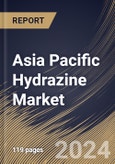Likewise, exploring alternative energy sources has spurred interest in hydrazine as a potential fuel for fuel cells. Researchers and industry players are actively investigating the viability of hydrazine-based fuel cells as a cleaner and more efficient energy solution. Researchers are exploring the development of Direct Hydrazine Fuel Cells (DHFCs) where hydrazine is directly used as the fuel without the need for intermediate hydrogen production. This direct utilization simplifies the fuel cell system and enhances efficiency. Hydrazine exhibits high energy density, a critical parameter for fuel cells. The controlled decomposition of hydrazine can release a significant amount of energy, making it an efficient fuel source for generating electrical power in fuel cells.
In addition, ongoing research and development efforts in the aerospace sector focus on enhancing propulsion systems for space exploration. Hydrazine remains a subject of interest in the quest for more advanced and efficient rocket propulsion technologies. Technological advancements in synthesis processes are shaping the production of hydrazine and its derivatives. Innovations aimed at improving efficiency, reducing environmental impact, and ensuring safety are key drivers in the evolving landscape of hydrazine synthesis.
The China market dominated the Asia Pacific Hydrazine Market, By Country in 2022, and would continue to be a dominant market till 2030; thereby, achieving a market value of $116504.1 Thousands by 2030. The Japan market is registering a CAGR of 4.6% during (2023 - 2030). Additionally, The India market would experience a CAGR of 5.2% during (2023 - 2030).
Hydrazine is used in the synthesis of certain pharmaceuticals and agrochemicals. With the pharmaceutical industry expanding in China, driven by population growth, increased healthcare needs, and a focus on research and development, the demand for hydrazine may rise as a key chemical in the production process. Hence, the growing chemical and pharmaceutical sectors in the Asia Pacific will assist in the expansion of the regional hydrazine market.
Based on Application, the market is segmented into Blowing Agents, Water Treatment, Agrochemicals, Pharmaceuticals and Others. Based on countries, the market is segmented into China, Japan, India, South Korea, Australia, Malaysia, and Rest of Asia Pacific.
List of Key Companies Profiled
- Lanxess AG
- Nippon Carbide Industries Co., Inc.
- Bayer AG
- GFS Chemicals, Inc
- Japan Finechem Inc.
- BASF SE
- LGC Science Group Holdings Limited
- Arkema S.A.
- Arrow Fine Chemicals
- Lonza Group Ltd.
Market Report Segmentation
By Application (Volume, Hundred Tonnes, USD Million, 2019-2030)- Blowing Agents
- Water Treatment
- Agrochemicals
- Pharmaceuticals
- Others
- China
- Japan
- India
- South Korea
- Australia
- Malaysia
- Rest of Asia Pacific
Table of Contents
Companies Mentioned
- Lanxess AG
- Nippon Carbide Industries Co., Inc.
- Bayer AG
- GFS Chemicals, Inc
- Japan Finechem Inc.
- BASF SE
- LGC Science Group Holdings Limited
- Arkema S.A.
- Arrow Fine Chemicals
- Lonza Group Ltd.
Methodology

LOADING...








